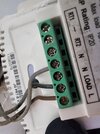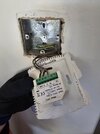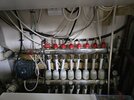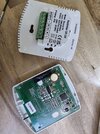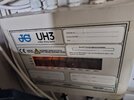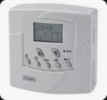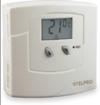I'm hoping for someone to help explain the below - I'm not an experienced DIYer but always willing to learn...
We have wet underfloor heating on the ground floor and one of the old underfloor heating thermostats (from about 2012) blanked out after a power cut. Basically, the screen never came back to life (it had blanked out previously when being programmed but then recovered). While looking for a replacement we were advised by Heatmiser that the direct replacement would be their Slimline V4 model (photo attached). Thinking it is a straight swap we opened the box and found out that we seem to have an electric underfloor heating thermostat - a PRT-E (photos attached).
Called Heatmiser back to ask what to do - they told us that they have no idea why an electric thermostat should have been installed on a wet underfloor system and that we should still use the Slimline V4 rather than the Slimline-E V3, their electric variant (in that case I have no idea where the black wire would go that is currently going into the Load terminal...).
Would anyone have an idea about why the installers might have used an electric thermostat on a wet underfloor system and what the issue would be with replacing it with the Slimline-E V3 version again? Taking into account that:
- There are 4 additional thermostats on the same floor, which I suspect would be the same electric version
- We definitely have wet underfloor heating with a system boiler (hot water tank) - photos attached
- The house was built at the same time the thermostats were installed (2012) and although we've only been here for a couple of years, we haven't noticed any issues (the last check of the electrics was in 2022).
Also, I'm not sure why there is no probe - the new E-V3 version seems to come with a probe. TBH, all the thermostats seem to be showing an ambient temperature that is too high but we have got used to it.
Thank you!
We have wet underfloor heating on the ground floor and one of the old underfloor heating thermostats (from about 2012) blanked out after a power cut. Basically, the screen never came back to life (it had blanked out previously when being programmed but then recovered). While looking for a replacement we were advised by Heatmiser that the direct replacement would be their Slimline V4 model (photo attached). Thinking it is a straight swap we opened the box and found out that we seem to have an electric underfloor heating thermostat - a PRT-E (photos attached).
Called Heatmiser back to ask what to do - they told us that they have no idea why an electric thermostat should have been installed on a wet underfloor system and that we should still use the Slimline V4 rather than the Slimline-E V3, their electric variant (in that case I have no idea where the black wire would go that is currently going into the Load terminal...).
Would anyone have an idea about why the installers might have used an electric thermostat on a wet underfloor system and what the issue would be with replacing it with the Slimline-E V3 version again? Taking into account that:
- There are 4 additional thermostats on the same floor, which I suspect would be the same electric version
- We definitely have wet underfloor heating with a system boiler (hot water tank) - photos attached
- The house was built at the same time the thermostats were installed (2012) and although we've only been here for a couple of years, we haven't noticed any issues (the last check of the electrics was in 2022).
Also, I'm not sure why there is no probe - the new E-V3 version seems to come with a probe. TBH, all the thermostats seem to be showing an ambient temperature that is too high but we have got used to it.
Thank you!


